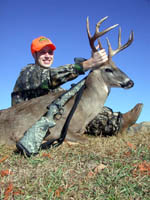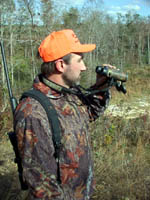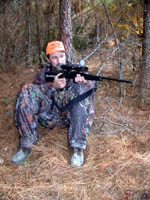
|
Features
|
|
|
|
Books
|
|
|
|
Fun & Games
|
|
|
|
Contact Us
|
|
|
John's Journal... Entry 224, Day 3
HOW TO BECOME A VERSATILE DEER HUNTER
Stalk Hunting
 Editor's
Note: Successful deer hunting involves problem solving and decision making.
But to consistently succeed, you must know when to change strategies and
why to abandon a hunt plan and have the flexibility to institute those
changes. Weather, hunting pressure, the availability of food, the rut
and your intuition all determine how, when and where you should hunt.
You must be versatile.
Editor's
Note: Successful deer hunting involves problem solving and decision making.
But to consistently succeed, you must know when to change strategies and
why to abandon a hunt plan and have the flexibility to institute those
changes. Weather, hunting pressure, the availability of food, the rut
and your intuition all determine how, when and where you should hunt.
You must be versatile.
Stalk hunting is almost a lost hunting art. Society has taught us all that the faster we go and the more ground we cover, the quicker we get whatever we're trying to obtain. However, you'll not find this philosophy true when applied to deer hunting. A consistently-successful stalk hunter often will cover no more than 50 to 100 yards in an hour. This man realizes that the slower he goes, the more deer he sees. The stalk hunter also must be conscious of hunting into the wind. If the wind changes directions, he generally will alter the direction of his stalk.
 The
successful stalk hunter hunts one-footed. He places his heel on the ground
and then slowly rocks his foot forward, feeling every stick and branch
under his foot. If he feels a twig that will pop, he'll readjust his foot
to dodge the sticks. Then he won't break the twig before he shifts his
weight to stand on that foot. Once he's shifted his weight to the foot
he's just put down, he'll raise the other foot off the ground and slowly
move it forward, repeating the same precise step that he has made before.
Most of the time he'll have all the weight of his body on one foot.
The
successful stalk hunter hunts one-footed. He places his heel on the ground
and then slowly rocks his foot forward, feeling every stick and branch
under his foot. If he feels a twig that will pop, he'll readjust his foot
to dodge the sticks. Then he won't break the twig before he shifts his
weight to stand on that foot. Once he's shifted his weight to the foot
he's just put down, he'll raise the other foot off the ground and slowly
move it forward, repeating the same precise step that he has made before.
Most of the time he'll have all the weight of his body on one foot.
At the same time the stalk hunter takes these slow, deliberate steps, he looks in all directions for the swish of a tail, the inside white of a deer's ear, the black circle of a deer's eye or the parallel line about 3 feet off the ground of a deer's back. Once he spots the animals, he slows his stalk down, analyzes what the deer are doing and where they want to go and determines where he must stand to make the shot.
 The
best weather conditions for stalking include. . .
The
best weather conditions for stalking include. . .
* after a rain when the ground is wet and the leaves won't pop and crack
under your feet,
* during a rainstorm when the wind and the rain can hide your movements
and the sound of your walking and/or
* on wet, windy days when the wind will disguise your movement and the
sound of your walking.
TOMORROW: MAN DRIVING
Check back each day this week for more about HOW TO BECOME A VERSATILE DEER HUNTER ...
Day 1 - Stand Hunting
Day 2 - Still Hunting
Day 3 - Stalk Hunting
Day 4 - Man Driving
Day 5 - How to Know When to Do What